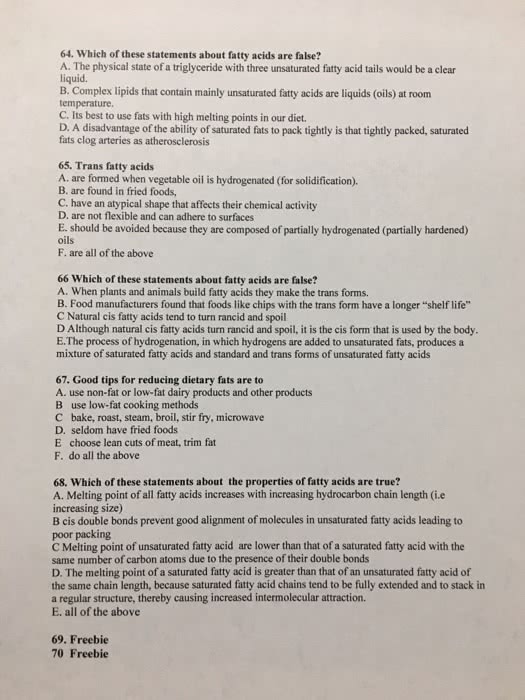Question 401 pts
Kinetic energy is the stored energy that can be used for motion.
Flag this Question
Question 411 pts
When an electron is transferred from one atom to another, and the two atoms are then electrically attracted to one another, a(n) ________________ bond is formed.
Flag this Question
Question 421 pts
Changing the number of ____________ of an atom would change the chemical properties of the atom.
Flag this Question
Question 431 pts
Forming molecules and breaking down molecules in biological organisms usually requires the use of _________ to help the reaction proceed faster.
Flag this Question
Question 441 pts
Organic molecules have a core composed of .
Flag this Question
Question 451 pts
The building blocks of carbohydrates are
Flag this Question
Question 461 pts
Water molecules crossing a membrane from high to low concentration is .
Flag this Question
Question 471 pts
Choose the membrane molecule responsible for the passage of polar molecules and ions into and out of the cell.
| transmembrane channel proteins |
Flag this Question
Question 481 pts
The simplest cells are .
Flag this Question
Question 491 pts
Which of the following membrane bound organelles are found inside bacterial cells:
| organelles are not found in prokaryotic cells |
Flag this Question
Question 501 pts
Which of the following is a specialized components of the cell, is associated with the rough endoplasmic reticulum, and is responsible for making proteins.
Flag this Question
Question 511 pts
Proteins are sorted, modified, and packaged by the _____________ and later transported to the outside of the cell.
| golgi bodies (golgi apparatus) |
Flag this Question
Question 521 pts
Dehydration synthesis is a process of linking two smaller subunits together to form a polymer. Which of the following statements below is true of dehydration synthesis?
| A water molecule is removed from the molecules. |
| A water molecule is added to the molecules |
| Carbon dioxide is given off. |
Flag this Question
Question 531 pts
Proteins are made up of _________ held together by peptide bonds.
Flag this Question
Question 541 pts
Which of the following gives an amino acid its properties?
| R Group or functional group |
Flag this Question
Question 551 pts
The final three-dimensional shape of a protein that includes the bonding of two or more polypeptide chains is call its _____ structure.
Flag this Question
Question 561 pts
How do DNA and RNA differ?
| all statements are differences between DNA and RNA. |
| DNA is double stranded while RNA is single stranded. |
| They have different sugars. |
| Thymine is present in DNA but not in RNA. |
Flag this Question
Question 571 pts
Which of the following is a component of a DNA nucleotide?
| a nitrogen containing base |
| All are components of a nucleotide. |
Flag this Question
Question 581 pts
Cell membranes are made up of several different types of molecules. Select the membrane molecule below that is made up of a polar region and two non-polar fatty acid tails.
Flag this Question
Question 591 pts
Two organelles which are believed to have once been free-living bacterial cells are ____________ and ______________.
| chloroplasts and mitochondria |
| golgi apparatus and endoplasmic reticulum |
| peroxisomes and lysosomes |
Flag this Question
Question 601 pts
The is an extensive system of internal membranes responsible for producing carbohydrates and lipids.
| smooth endoplasmic reticulum |
| rough endoplasmic reticulum |



